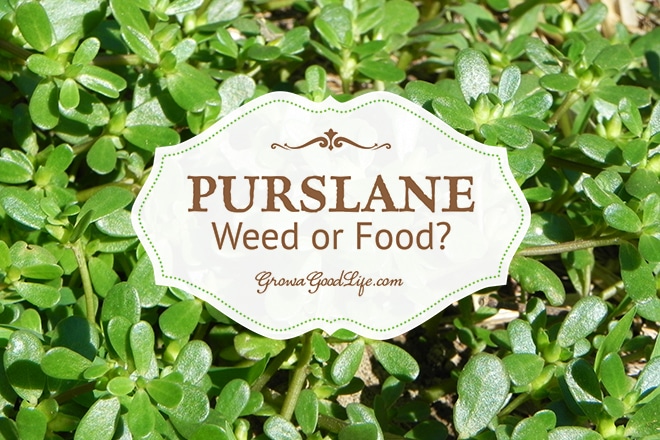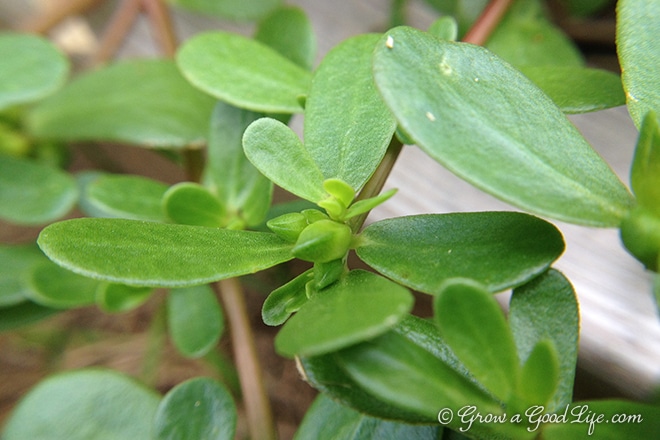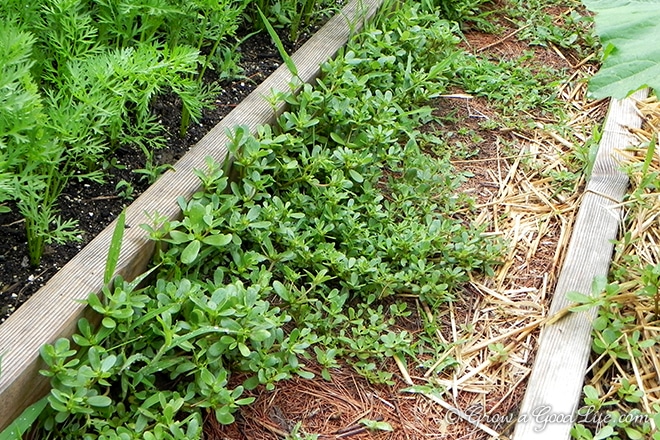Purslane: Weed it or Eat it?
This post may contain affiliate links, which means that I may receive a commission if you make a purchase using these links. As an Amazon Associate I earn from qualifying purchases.
Have you found purslane in your garden and are you wondering if you should weed it or eat it?

Common Purslane (Portulaca Oleracea), also known as pigweed, little hogweed, or Ma Chi Xian, is a low growing succulent member of the Portulacaceae family. It is considered an annual herb that grows in almost all corners of the world in various soil conditions. To most, it is a pesky weed that sprouts up between cracks in the sidewalks, in garden beds, open areas in paths.
I have received some comments on the Purslane that I am showing in the last few Harvest Monday posts July 6, 2014 and July 14, 2014. So I thought I would share some of the research and information I have learned about Purslane.

So is Purslane a weed or food?
It is all a matter of perspective…A weed is considered to be any unwelcome or troublesome plant, especially one that grows abundantly where it is not wanted. While food is any nourishing substance that is eaten, drunk, or otherwise taken into the body to sustain life, provide energy, and promote growth.
Purslane is a rather abundant in my garden this year. It is growing in the newly constructed raised beds and in the paths. I’ve been weeding it in areas where it may compete for moisture and nutrients with crops, but have allowed it to grow in corners and in paths. The weeded plants are not tossed away. I have been plucking the succulent leaves and adding them to salads, stir fry, and scrambling them up with my morning eggs.

So why am I eating a weed?
Purslane is packed with nutrition: Purslane is low in calories, high in fiber, an excellent source of the essential amino acids, and vitamins A, C and E. Purslane also has one the highest known concentrations of Omega-3 fatty acid in any plant. (source: HealthGuidance and USDA)
In his book, In Defense of Food: An Eater’s Manifesto Michael Pollan praises Purslane as one of the healthiest plants on the planet:
“Two of the most nutritious plants in the world are weeds—lamb’s quarters and purslane—and some of the healthiest traditional diets make frequent use of wild greens,” ~Michael Pollan, In Defense of Food: An Eater’s Manifesto
Purslane requires no effort to grow: Purslane grows freely and tolerates different light intensities, temperature ranges and soil types. There is no work involved in growing purslane. It is a free source of nutritious food. Purslane easily reproduces from stem pieces and seeds with no effort on our part. It’s succulent characteristic makes it very drought tolerant.
Purslane tastes good: Purslane’s succulent-like leaves have a refreshingly crisp, slightly lemon flavor with a nice crunch that make a wonderful addition to any salad. The stems have a tangy and peppery kick. Personally, I find the stems to be a little tough but the leaves are tossed onto pizza, scrambled up in eggs, added as a burger topping, and snacked on while I am in the garden.
In addition, Purslane has been used since ancient times to treat various health conditions. In Traditional Chinese Medicine, Portulaca Oleracea is called Ma Chi Xian and is used to aid in clearing heat, expelling toxins, and cooling blood. It is sour in taste and cold in nature and goes to meridians of liver and large intestine. (source: TCM Assistant and TCM Wiki)
I will continue to consume Purslane moderately in regular meals and encourage you to give this free food resource a try. I have gathered some Recipes for Purslane on Pinterest:
Follow Grow a Good Life’s board ~ Purslane Recipes ~ on Pinterest.
Further Reading:
- University of Illinois Extension. ” If you can’t beat it; eat it!”
- Chinese Herbs Healing, “Portulaca Oleracea (Purslane, Ma Chi Xian)”
- USDA National Nutrient Database. “Full Report (All Nutrients): 11427, Purslane, raw”
- UC IPM Online. “Common purslane (Portulaca oleracea)”
- Herbal Academy of New England, “Purslane – An Omega 3 Rich Vegetable”
Disclosure: Any medical information is for informational purposes only. Always exercise caution when using any wild plants and make sure you have positively identified the plant.
You May Also Like:
- Chokecherry Jelly from Foraged Fruit
- Growing Chamomile from Seed to Tea
- Wild Violet Vinegar Infusion
- Fresh Strawberry Vinaigrette Salad Dressing
- Mason Jar Italian Salad Dressing
Good planning is key to a successful vegetable garden
Whether you are new to growing your own food or have been growing a vegetable garden for years, you will benefit from some planning each year. You will find everything you need to organize and plan your vegetable garden in my PDF eBook, Grow a Good Life Guide to Planning Your Vegetable Garden.



Thank you! I hear other gardeners saying they eat this stuff all the time but I didn’t know what it looked like. I have some in my own yard. I will definitely give it a try.
I love it! Thanks for all the good info! We, like you, let our purslane grow wild in our garden and toss it into various meals, though you have inspired me to do it more frequently. 🙂
I am very excited about finding the health benefits of this amazing weed..I learned about it from a friend who has lung cancer..and she if wonderful..I am a bit obsessed with finding it..planting purslane in a pot..and I am a little scared to eat it! Ha, who knew? Never too late to learn,
Found you on Wildcrafting Wednesday and love the post. I am always looking at the weeds in my garden and wondering what healing powers they may hold (although I wish they all had some use). I will happily add purslane the list of “useful” weeds.
Annie, Thanks for stopping by and leaving a comment. I wish all garden weeds were as healthy as purslane.
I’ve found a couple of purslane plants this summer, and transplanted one of them to my rock garden. Thank you for sharing this at the HomeAcre Hop; I hope you’ll join us again this Thursday. Kathi at Oak Hill Homestead
Kathi, I bet the purslane will grow from now on in your rock garden. They tend to self seed easily and can even grow from a part of the plant.
I grow purslane in a pot for the flowers, but on looking it up, featured it in a blog post as an edible. I found it quite delicious and put some bits in a salad, though I don’t have quantities enough to serve it as a side.
Bev, it is a pretty plant. Also in my reading, I discovered that purslane helps other plants by drawing up moisture from deeper in the ground and sharing it (Source: http://herbalacademyofne.com/2012/07/purslane/).
When we broke ground for the first Impact Community Garden, purslane started sprouting up everywhere between rows and plants. I showed everyone it was edible, and folks had a great time eating it. I gave away seeds last year for the green and golden varieties. It’s such a nutritious ‘weed’!
Dave, I love seeing the reactions on people’s faces when I pluck and eat what they think of as a weed. It’s a great way to educate.
Purslane is the best source of Omega 3 essential oils out of all land-based vegetables. Love it! http://herbalacademyofne.com/2012/07/purslane/
Amber, Thanks for sharing! I have added this information under Further Reading.
Thanks for the write up and the photo of purslane, I read or heard about Ma Chi Xian (馬齒莧) in Chinese periodicals or discussion forums often, but they never show a picture of it, I see Asian markets sell purslane, but they don’t label it or the label is in Vietnamese or other language which I couldn’t read.
Just for fun, guess what purslane means in Chinese?
Ma=馬=horse; Chi=齒=tooth; Yan=莧=amaranth
Ma Chi Xian = Horse Tooth Amaranth; ( the leaves of purslane do look a bit like horse teeth :P)
Mac, Thanks for the translation. I hope you will give it a try.
Interesting and timely, since purslane seems to be one of the most prominent weeds in the garden this year, along with yellow wood sorrel. I may have to try it, if only because of its omega-3 content.
Dave, Let me know what you think 🙂
The first time I had this was when I was living in Turkey. I came to really love it.
I chop it up, a lot of it. My kids love it. After chopping I add it to yogurt, and garlic.
Taste great!